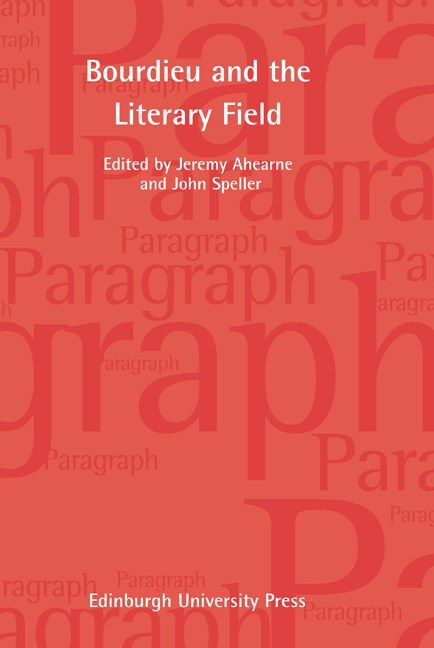Book contents
- Frontmatter
- Contents
- Introduction: Bourdieu and the Literary Field
- How Field Theory Can Contribute to Knowledge of World Literary Space
- Autonomy Revisited: The Question of Mediations and its Methodological Implications
- The Literary Field and the Field of Power: The Case of Modern China
- Between Repression and Anamnesis: Pierre Bourdieu and the Vicissitudes of Literary Form
- Reading and Reflexivity: Bourdieu’s Faulkner
- Fields and Fragments: Bourdieu, Pascal and the Teachings of Literature
- On an Enigmatic Text by Pierre Bourdieu
- Apollinaire, Autumn Ill
- Notes on Contributors
Reading and Reflexivity: Bourdieu’s Faulkner
Published online by Cambridge University Press: 17 September 2020
- Frontmatter
- Contents
- Introduction: Bourdieu and the Literary Field
- How Field Theory Can Contribute to Knowledge of World Literary Space
- Autonomy Revisited: The Question of Mediations and its Methodological Implications
- The Literary Field and the Field of Power: The Case of Modern China
- Between Repression and Anamnesis: Pierre Bourdieu and the Vicissitudes of Literary Form
- Reading and Reflexivity: Bourdieu’s Faulkner
- Fields and Fragments: Bourdieu, Pascal and the Teachings of Literature
- On an Enigmatic Text by Pierre Bourdieu
- Apollinaire, Autumn Ill
- Notes on Contributors
Summary
Abstract:
A rarely examined internal reading by Bourdieu at the end of The Rules of Art of William Faulkner's short story ‘A Rose for Emily’ provides the starting point for a reflection on Bourdieu's theories of reading and reflexivity. The article begins by looking at Bourdieu's theory of literary reception, and its identification of two distinct modalities of reading, ‘scholastic’ and ‘naive’. It then places Bourdieu's discussion of ‘A Rose for Emily’ as a ‘reflexive’ text in the context of his wider theory of reflexivity. Bourdieu's approach to reading Faulkner’s text is compared with those deployed elsewhere by more established literary critics, notably Jean-Paul Sartre and Roland Barthes. Finally, the question of how his internal reading fits within the logic of a theoretical work devoted to the ‘reflexive’ practice and method of field analysis is discussed.
Keywords: Pierre Bourdieu, William Faulkner, reflexivity, reading, double historicization, ‘A Rose for Emily’
Tucked away at the end of The Rules of Art, is a reading by Pierre Bourdieu of William Faulkner's short story ‘A Rose for Emily’. Rarely remarked on by critics, this analysis is interesting for several reasons. Most strikingly, it is an internal reading of a text at the end of a work that has spent most of its length extolling field analysis, and chiding other modes of reading, from New Criticism to structuralism and deconstruction, for failing to position works in their socio-historical contexts. Indeed, it could be seen as demonstrating effectively what a good ‘internal’ reading can do on its own terms: it provides a key not only for understanding the text we are reading, but also the very process by which we come to an understanding of that text. Bourdieu's argument is that Faulkner's short story is designed as a sort of prompt for the reader to engage in just such a reflection and auto-reflection. This article will take us through Bourdieu's analysis of the structure of ‘A Rose for Emily’ and how it plays on our unquestioned assumptions and expectations, only then to send us back to examine those same techniques and presuppositions. Along the way, Bourdieu's approach to reading this text will be compared with those deployed elsewhere by more established literary critics, notably Jean-Paul Sartre and Roland Barthes.
- Type
- Chapter
- Information
- Bourdieu and the Literary FieldParagraph Volume 35, Number 1, pp. 83 - 96Publisher: Edinburgh University PressPrint publication year: 2020



